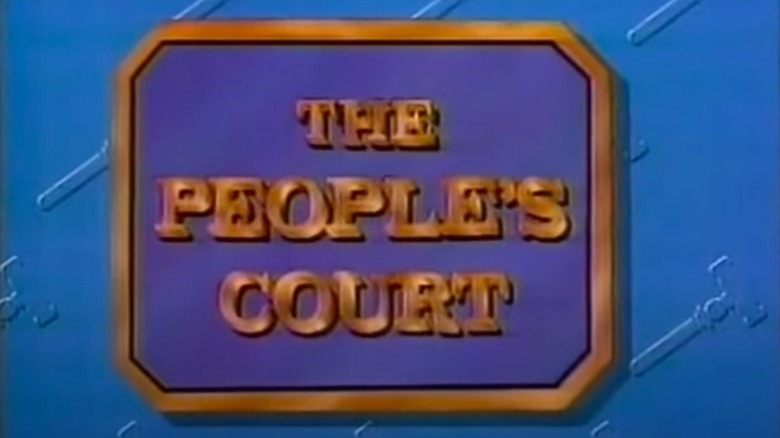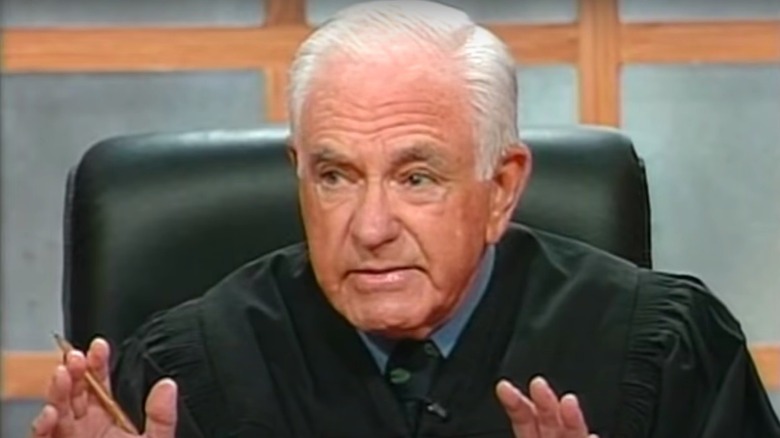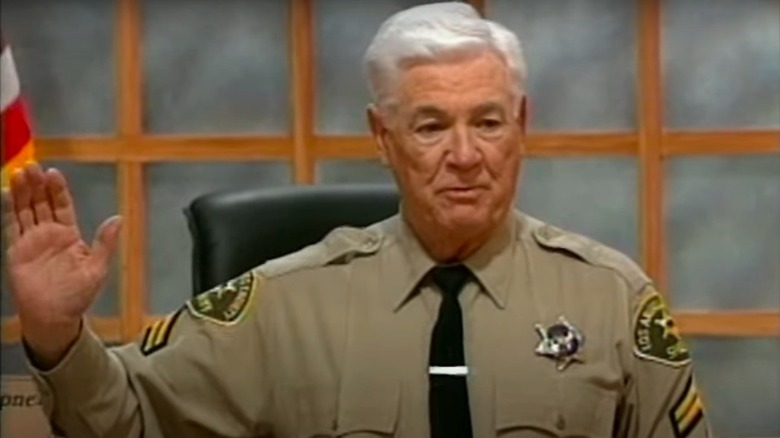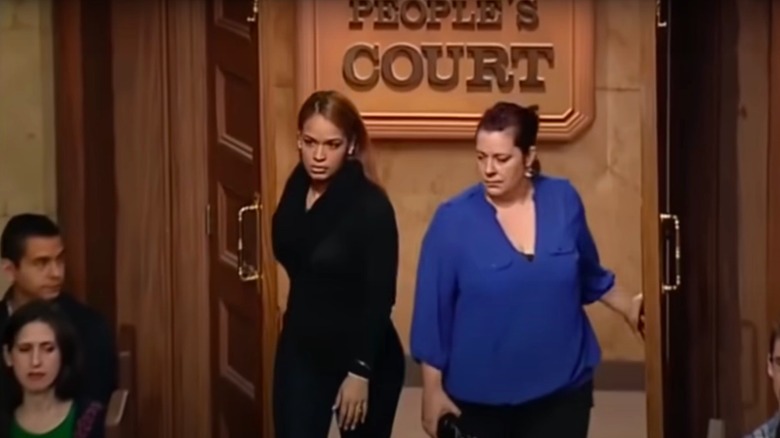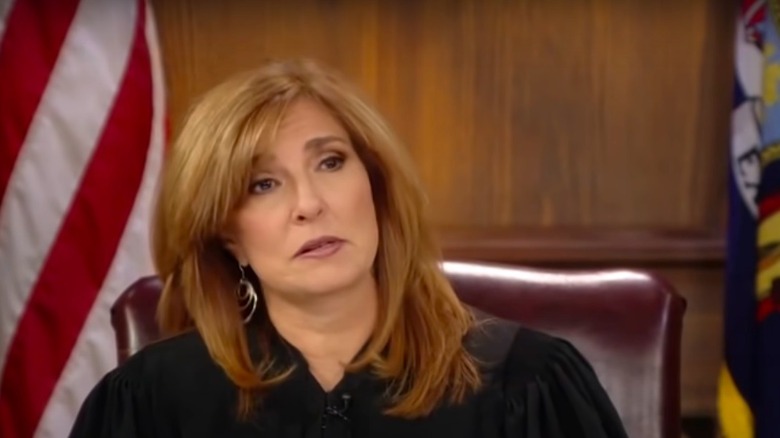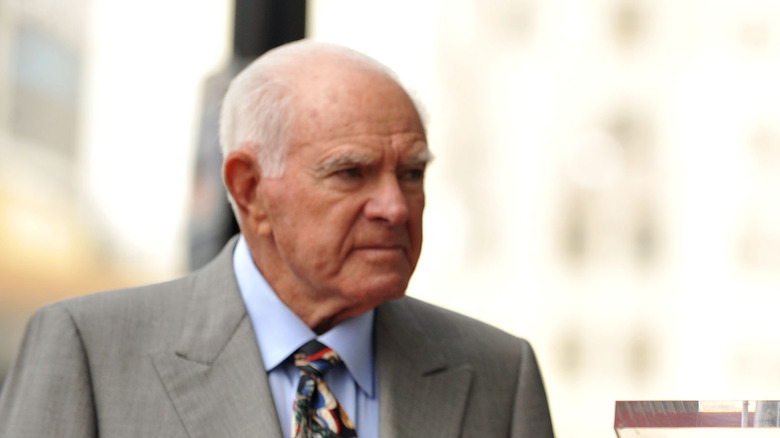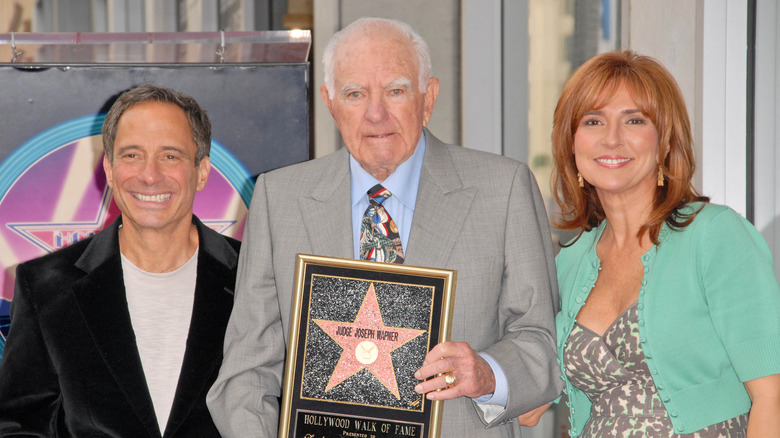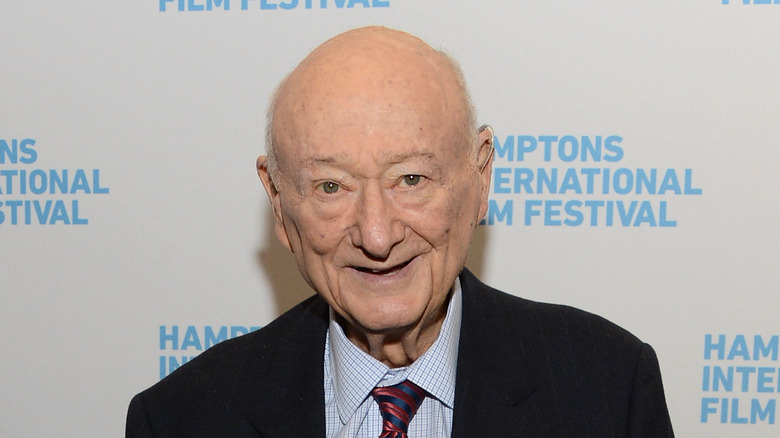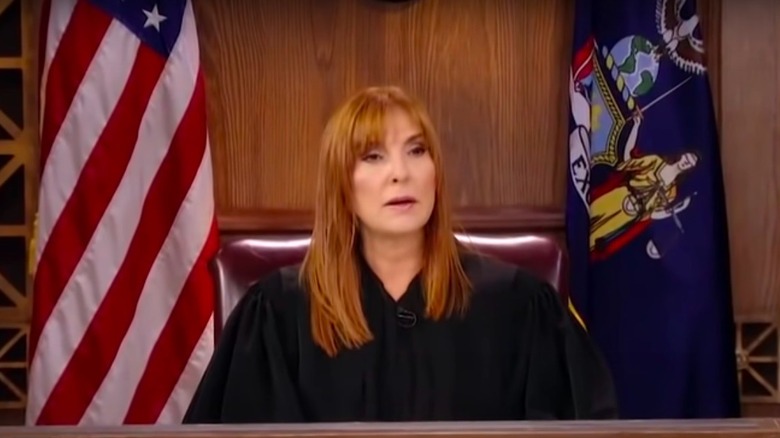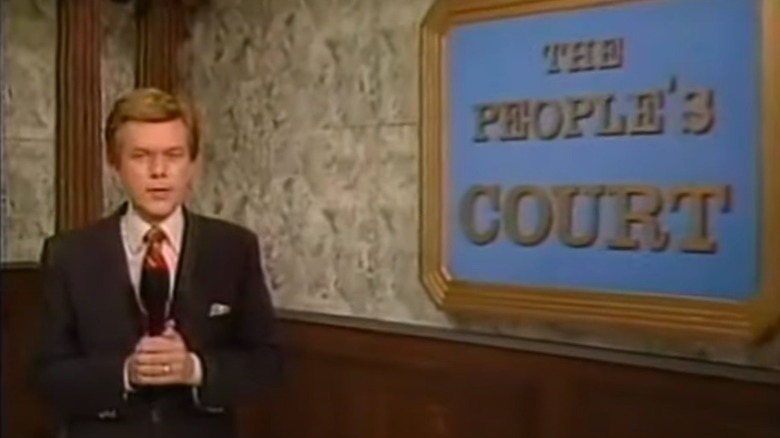The Untold Truth Of The People's Court
While daytime television is currently bursting with courtroom shows featuring judges ruling over cases, every single one of them, from "Judge Judy" to "Judge Joe Brown," owes a debt to the originator of them all: "The People's Court." Making its debut in 1981, "The People's Court" introduced viewers to Judge Joseph Wapner, who presided over the faux TV courtroom to rule on actual cases culled from small claims court. As the defendants and plaintiffs argued their respective cases, Wapner would then render his final decision — a format viewers seemed to love.
When the series was cancelled in 1993 after a respectable 12-season run, that wasn't the end for "The People's Court." A revamped revival was launched in 1997 with a new judge, while the show's format remained more or less unchanged. The show's current star, Judge Marilyn Milian, took over in 2001, and has remained behind the bench ever since. In 2013, when the show celebrated its 30th anniversary season, its studio, Warner Bros., declared at the time that "The People's Court" was watched by 8 million total viewers each week, with nearly 4 million of those identified as women "in the coveted 18-plus demographic."
Despite being a fixture on daytime television for nearly four decades, there's a lot about this venerable TV institution that viewers may not realize. So just what is the untold truth of "The People's Court?"
No network wanted to air The People's Court
It's not hyperbole to say that "The People's Court" singlehandedly created an enduring sub-genre of daytime television that hadn't previously existed. However, when John Masterson started shopping around his original concept, the response to the show wasn't exactly overwhelming. "Back in '75, I couldn't sell it," Stu Billett, the television executive originally tasked with pitching the show to television networks, told the Metropolitan News-Enterprise. "The networks didn't want it."
Of course, Masterson's concept was markedly different from the series that eventually made it on the air. Masterson had envisioned a show that aired filmed excerpts of real legal cases filmed in actual courtrooms. When the option ran out and the show remained unsold, Billett felt there was still something to the idea. To hone in on a concept of his own, Billett visited courtrooms to watch cases unfold. "It was so dull," he recalled. Then he paid a visit to small-claims court, where he witnessed some "funny, funny cases." When he discovered that 75,000 small-claims cases were filed in Los Angeles each year, Billett realized he'd struck gold.
Understanding that filming within actual courtrooms would be prohibitive, Billett revamped the format so cases would take place in a faux courtroom at a TV studio. After a pilot was shot featuring retired Los Angeles Superior Court Judge Joseph A. Wapner, "The People's Court" ultimately debuted in syndication.
The People's Court almost became a comedy show
During the period when Stu Billett tried to sell television networks on the concept of what would eventually become "The People's Court," NBC did express some interest. However, what NBC executives envisioned was a far cry from what Billett was picturing.
As Billett told the Metropolitan News-Enterprise, NBC was interested in a show with more comedic elements, eager to cast a Black comedian such as Nipsey Russell — who was "real hot then" — as the judge, who would "listen to a case and make jokes." As Billett recalled, the comedian/judge would be "coached by a real judge" during a commercial break before rendering the ruling to viewers.
"It was a stupid idea," Billett admitted of the comedy spin that NBC wanted to put on the project. However, when Billett discussed NBC's proposal with Tony Cassara, president of the company that owned local TV station KTLA, Cassara suggested Billett use KTLA's studios to produce two pilots, one using NBC's comedy idea and one following Billett's original vision. Once Billett produced his "straight" pilot with retired judge Joseph Wapner, however, he admitted he "couldn't go through with making a humorous version." As he told Cassara, "they're real cases" that should be decided by a judge, not a standup comic. Ultimately, Billett stayed true to his concept, and TV history was made.
Judge Wapner never once used his gavel
Judge Joseph A. Wapner spent his career hearing cases in Los Angeles Superior Court, and had retired from the bench when he was approached to join "The People's Court." While the cases he adjudicated weren't legally binding, Wapner nevertheless approached them with the same thoughtfulness he had when he was an actual judge.
During his years as a judge — both in real life and on television — Wapner had a gavel by his side, but didn't actually ever see the need to bang it. "I never once used a gavel in 20 years. Even on 'People's Court,' I used it mainly as a prop," he revealed in an interview with the Los Angeles Times. The reason, he explained, was because it was usually unnecessary to "make order in the court" when there was already a bailiff on hand to restore order if required.
Even though Wapner never used his gavel for professional purposes, he actually collected gavels as a hobby. According to the Times, Wapner's offices housed his collection, including miniature gavels, gavels within plaques and even one that had belonged to his father. Wapner's favorite gavel, however, was 3 feet tall and weighed a hefty 30 pounds, a commemorative gift he received in 1985 to celebrate the fourth season of "The People's Court."
Judge Wapner was instrumental in Rusty the bailiff being hired instead of 'a sexy girl'
Fans of the original iteration of "The People's Court" may have had a tough time seeing anyone other than Rusty Burrell in the bailiff role. However, had it not been for the insistence of the show's judge, Burrell may not have even been hired for that.
As the Metropolitan News-Enterprise recounted, "The People's Court" wasn't Burrell's first time as a TV bailiff. He'd previously appeared on "Divorce Court," in which real divorce cases were argued by actual lawyers, and actors portrayed the litigants. One of the lawyers tapped for that show was Wapner's father, Joseph Max Wapner, who had a pre-existing relationship with Burrell (who worked as real-life bailiff at the same time he played one on "Divorce Court"). As it turned out, the younger Wapner was instrumental in getting "The People's Court" executive producer Stu Billett to bring in Burrell. "I said to hire him," said Wapner of Burrell, who had recently retired from the L.A. Sheriff's Department.
Billett required some convincing, given that he wanted a "sexy girl" as bailiff instead. Wapner, however, would not be swayed. "No, you need Rusty," he told Billett. "He had a tremendous sense of humor. He knew people, he knew how to handle people," said Wapner of Burrell, who went on to work alongside the judge on both "The People's Court" and his subsequent series, "Animal Court."
The People's Court resulted in a surge of lawsuits in small claims court
For a show that featured a retired judge ruling on cases within a fake TV courtroom, "The People's Court" nevertheless managed to have a real-world impact on actual court cases. According to a 1989 story from the New York Times News Service (via The Free-Lance Star), the show's popularity not only increased the average person's knowledge of court procedures, but "The People's Court" had "vastly increased the caseload of once-obscure small-claims courts."
The show also had its critics. Superior Court arbitrator Thomas I. Friedman, who'd served as a night court judge, complained that "The People's Court" was "broadcasting some wrong impressions" about how small-claims court actually worked, leading to some misplaced expectations. "People walk into my court thinking it will be like what they saw on TV, and it's not," Friedman said, noting that some litigants even cited some of Judge Wapner's TV rulings "as if I should care — and I don't."
While Friedman continued to criticize "The People's Court" for its "showmanship" and "sarcasm," Wapner himself begged to differ, insisting the show actually "educates people in basic law" while instructing potential litigants how to effectively present a case within a courtroom. Judge Wayne D. Rhine, who had served as a consultant to "The People's Court," concurred, admitting he'd noticed the impact the show was having in his own courtroom. "Litigants today have a better idea of what they need in the way of proof," he explained.
A plaintiff sued to ensure her episode never aired
It's a given that 50% of the litigants on "The People's Court" will walk away unhappy. This is what happened to Claudia Evart, the plaintiff in a case in which she sued for the return of a $1,600 deposit she'd paid for a Murphy Bed. As the New York Post reported, Evart was so dismayed by what took place during her 2011 appearance on the show that she sued to prevent the episode from airing.
"It was a nightmare, and I wish I never did it," Evart told the Post, insisting she was seeking "justice" but was instead met with "aggravation and stress." As she explained, after her small-claims case was flagged by producers, she received a letter she felt made it "clear I had no chance of losing." However, that's not what happened when Judge Marilyn Milian ruled in favor of the defendant.
Following her loss, Evart complained that Milian "didn't let me speak," thus preventing her from effectively presenting her case. Even worse, Evart claimed Milian told her, "You always get what you want, but you're not gonna get what you want from me." Not only did Evart not get her deposit back, she griped that Milian robbed her of her self-respect. "You have the right to be treated with dignity," she said. "And I didn't give that right up." Ultimately, Evart lost her case and the episode was broadcast.
A woman mysteriously went missing after confronting her ex-fiancé on The People's Court
One of the many cases to play out on "The People's Court" involved Michelle Parker, who was embroiled in a legal dispute with her ex-fiancé, Dale Smith. At the heart of the case was a $5,000 engagement ring, which, Smith alleged, Parker hurled off a balcony while the pair engaged in a drunken argument. Parker made some allegations of her own, claiming that her ex had cheated on her multiple times during their relationship, and would become "pretty malicious and vindictive" toward her, "especially when he's been drinking."
As Parker's mother told ABC News, her daughter felt that appearing on the show was "the most humiliating experience of my life." Then, hours after the episode aired in the fall of 2011, Parker mysteriously vanished. At the time, a police spokesman said that Parker's disappearance was being investigated as "a missing person's case."
In 2020, nine years after Parker went missing, she still hadn't been found; the Orlando Police Department shared an update on social media, with a reward offered for information about her whereabouts. As the Orlando Sentinel reported in 2020, Smith had at one point been identified as a suspect in Parker's disappearance, but had never been charged.
The losers on The People's Court don't have to pay up
When litigants in small-claims court agree to bring their cases to television via "The People's Court," they waive their rights to have their cases play out in an actual court of law. In exchange for bringing these cases to television, reported Insider, losing litigants don't have to pay the settlements, with the show covering the costs on their behalf. In addition, the show will also pay for litigants' expenses if they need to travel to Los Angeles, where "The People's Court" is filmed.
These cases, noted Judge Marilyn Milian, are often more about making a point than making a buck.
"We once had a guy who paid $40 to file a case over a $5 lottery card," Milian told Insider. "And it was a thing of beauty, because what it shows you is that small claims is never about the money. It's always about the principle."
A former Mr. America sued The People's Court for making him look like a bully
Rex Ravelle was best known for winning the 1951 edition of the Mr. America bodybuilding competition. During the 1980s, however, he made headlines by being one of three people to sue "The People's Court" — and the first to win.
According to a report from the Los Angeles Daily News (via the Spokesman-Review), Ravelle appeared on the show to settle a dispute with a former tenant, claiming she owed him $2,000 in unpaid rent. While Ravelle felt he had an open-and-shut case, he claimed the instructions he was given to "project my voice and assert myself" during filming made him come across as a bully, while the female defendant appeared soft-spoken and meek. "This obvious ploy clearly established me as the big, macho villain," Ravelle complained after Wapner ruled in the defendant's favor.
He sued the show's production company for $1 million, eschewing legal counsel by representing himself. "Apparently my witness's testimony did not fit in the prejudged scenario by the producers of the show," Ravelle wrote in a letter he sent to producers. Ultimately, Ravelle's case never went to trial; instead, he dropped his suit in exchange for accepting a $2,500 settlement from Ralph Edwards Productions, which produced the show. However, Ravelle was adamant that had he pursued his lawsuit, he would have emerged victorious. "I had a good case, I could have pursued it against them," he insisted.
Judge Wapner returned to The People's Court for one very special episode
During the original decade-plus run of "The People's Court," the show transcended being merely a hit television series and became a pop-culture phenomenon. That was undeniably clear to anyone who watched the Oscar-winning film "Rain Man," in which Dustin Hoffman's character — who is on the autism spectrum — continually expresses his obsession with the show, becoming extremely agitated by the prospects of missing even a second of "The People's Court."
So it's no surprise that, when the decision was made to cancel the show in 1993, Wapner didn't fade from the public consciousness. In fact, more than a decade later, in 2009 he received a star on the Hollywood Walk of Fame. The following day, reported TV Series Finale, Wapner returned to the bench for a very special episode of "The People's Court," marking not just his 90th birthday but also the show's 3,000th episode.
Speaking about returning to the show, Wapner told the Television Foundation it was overall "a nice experience" that was "fun to do" — save for his interaction with Harvey Levin. Levin, founder of TMZ and legal anchor on "The People's Court," had tried to tell Wapner "what to do," something that irked the judge. "He got a little bit too big for his britches," said Wapner of Levin.
The People's Court was revived with a former NYC mayor
A few years after the cancellation of "The People's Court" in 1993, producers brought a revamped version of the show back to television. Debuting in 1997, this new version of "The People's Court" no longer featured Judge Joseph Wapner behind the bench. Sitting in his place was former New York City Mayor Ed Koch.
As a 1997 review from the Associated Press (via the Deseret News) pointed out, Koch was "a model of affability" when compared to the "gruff" Wapner. However, Koch insisted he was taking his role no less seriously than his predecessor. "I'm doing to the parties that come into that courtroom what I did as mayor," he told AP. "I want them to feel they got a fair shake from someone who cares about them."
Speaking with the Baltimore Sun in 1997, Koch addressed the differences between his approach to the show and that of Wapner. "I think Judge Wapner was a wonderful role model," Koch insisted. "I just happen to be different. He comes from California, that's orange juice. I come from New York, that's seltzer." Koch, who died in 2013, spent two seasons on "The People's Court," before being replaced by Judge Jerry Sheindlin in 1999. Sheindlin, in turn, exited after two seasons and was replaced by Judge Marilyn Milian in 2001.
Producers sift through thousands of cases to find the 'juiciest' ones
Viewers of "The People's Court" are told that the cases they watch play out on the show are actual legal conflicts from small-claims court. What they may not realize, however, is how many of those cases producers need to sift through before settling on the ones they feel will produce compelling television.
According to David Scott, executive producer of "The People's Court," finding the right cases is "like panning for gold." As he told Insider, there are some specific types of cases they look for. "We love a relationship case. We love where an ex-wife is suing their ex-husband," Scott said. "We love cases where there's a lot of personal kind of stuff along with the legal stuff. So it's the personalities that we're looking for. We're looking for a good argument, we're looking for a good defense. That's how we select our cases."
Judge Marilyn Milian put it even more succinctly when she told Insider that the show's ultimate goal was "to bring the public the juiciest cases we can get."
The show's original 'hallway guy' interviewer was brought back more than 20 years after he was last seen by viewers
In addition to Judge Joseph Wapner and bailiff Rusty Burrell, another member of the team for the original run of "The People's Court" was Doug Llewelyn. As viewers will recall, Llewelyn's role was to introduce the cases and then interview the litigants in the hallway outside the courtroom after Wapner made his decision.
When "The People's Court" was revived in 1997 following its 1993 cancellation, neither Wapner, Burrell, nor Llewelyn were invited back, with the original "hallway guy" replaced by Curt Chaplin. However, as The Inquisitr reported, Llewelyn was reinstated at the start of the 2016 season.
According to a press release, as reported by Reality Blurred, Llewelyn admitted that his return to the show more than 20 years later had been "the most shocking and pleasant surprise of my entire career ... who would ever have thought I'd be back in that courtroom hallway again?" In addition, Llewelyn also offered high praise for the show's current judge. "I love Judge Milian," he said. "She has such compassion for people. She's amazing ... even when she's mad!"
Judge Milian reveals the biggest mistake people make on The People's Court
Judge Marilyn Milian may not have been the first person to rule over cases on "The People's Court," but she does hold the honor of being the longest-lasting judge on the series, serving in the role from 2001 until now. Over the course of those two decades, Milian has made a lot of observations about the thousands of cases she's overseen.
"Absolutely the biggest mistake people make is coming unprepared," she said in an interview with Insider. "If you want a judge to rule against somebody and believe you, you have to bring evidence. You can't just show up with your flapping gums," she added. Milian also admitted she tends to become incredulous when people present their cases sans-evidence, and are then "insulted that you didn't just take their word for it. It's insanity."
That, Milian explained, is a key area in which "The People's Court" functions similarly to an actual courtroom. While some people may assume their word will be enough to sway a judge and jury, it clearly isn't. As Milian declared, "when there's two sides involved, you have to prove what it is you're saying."


